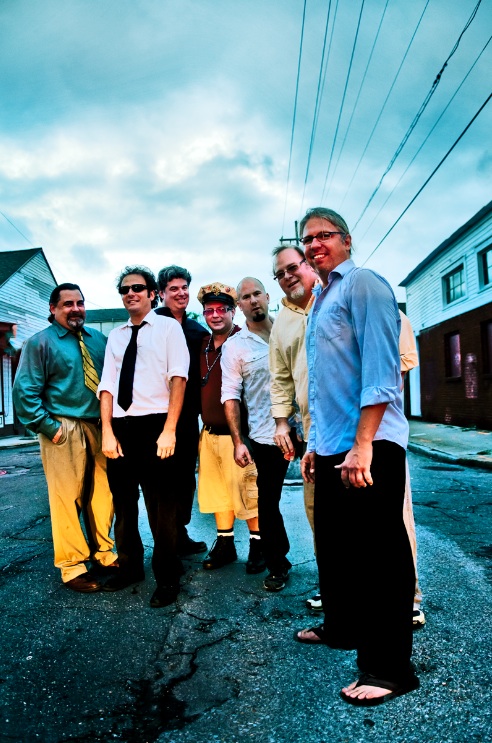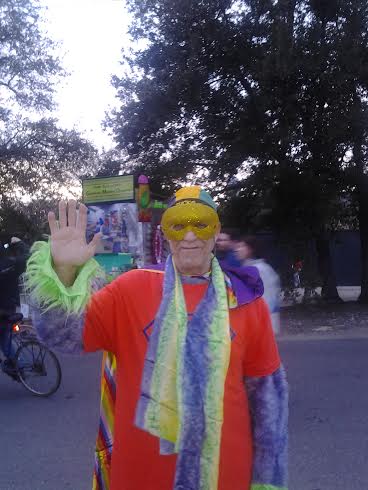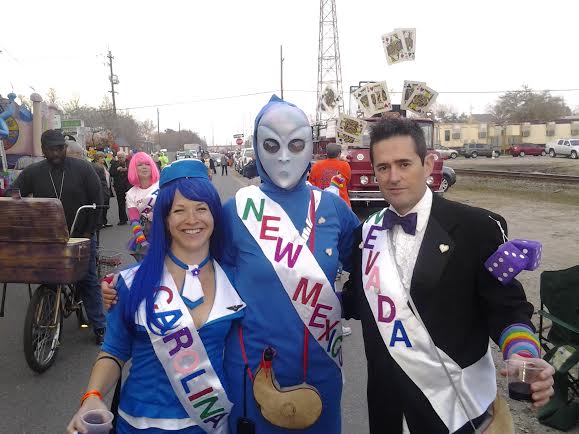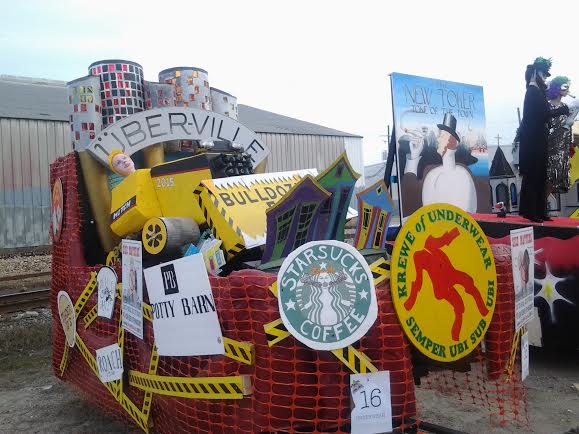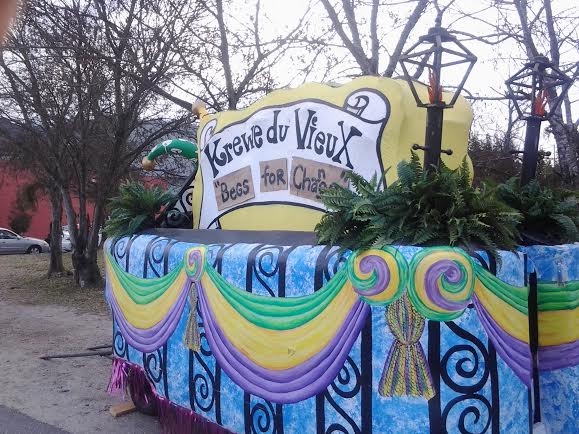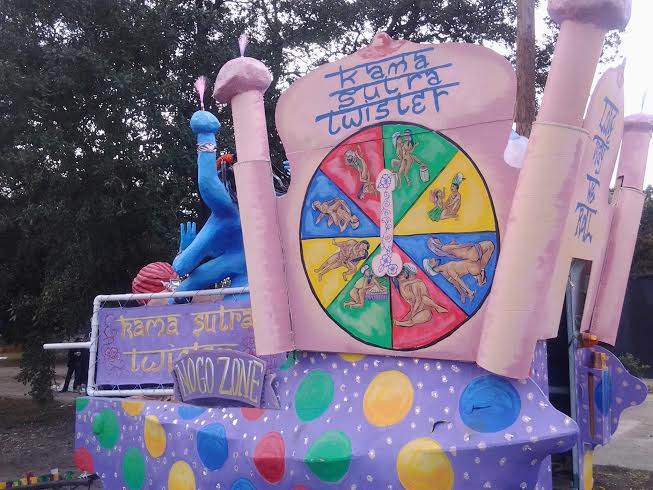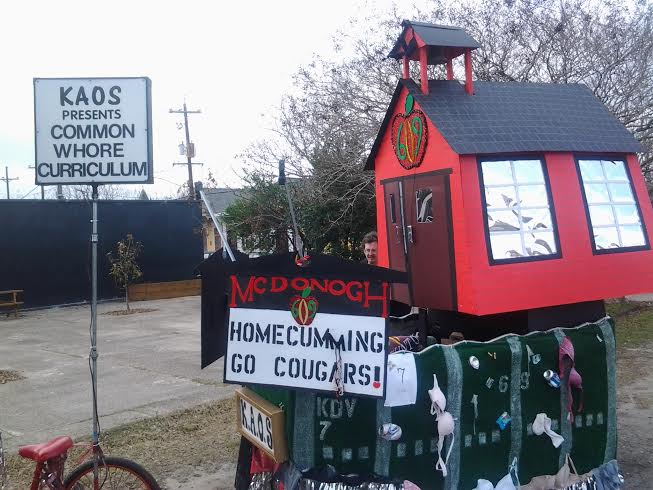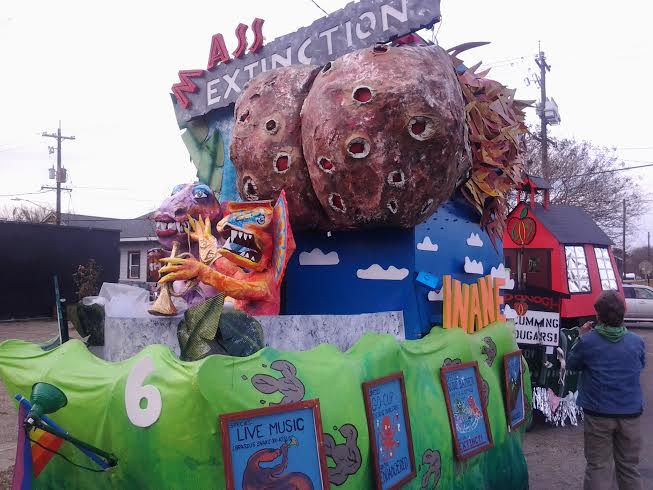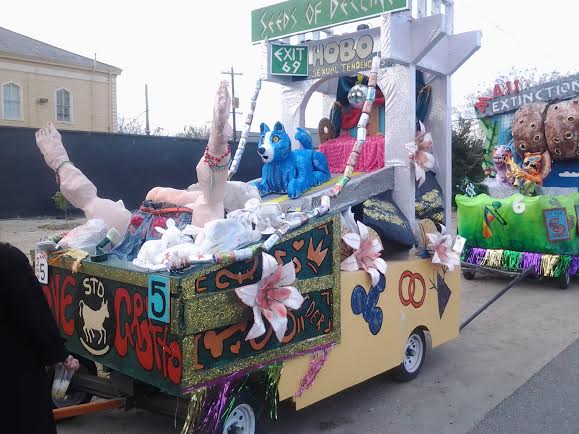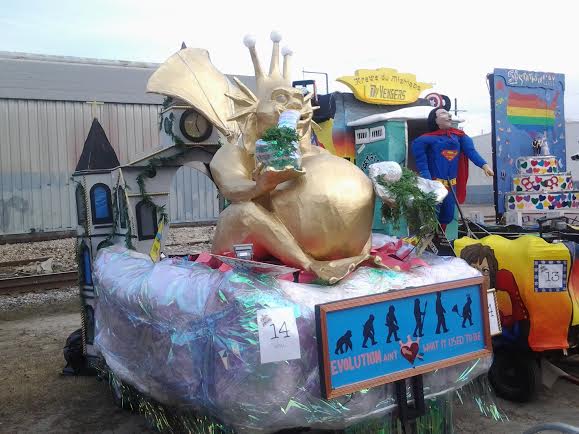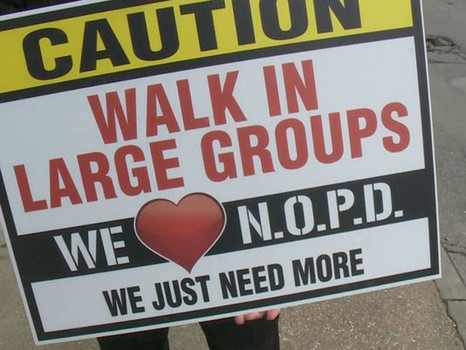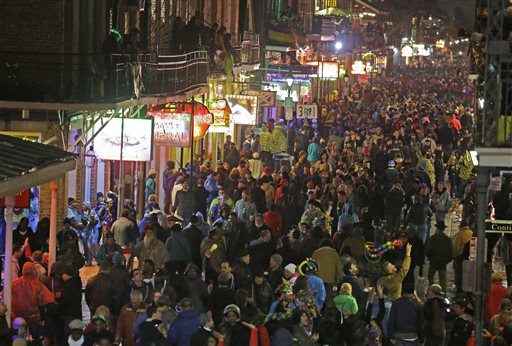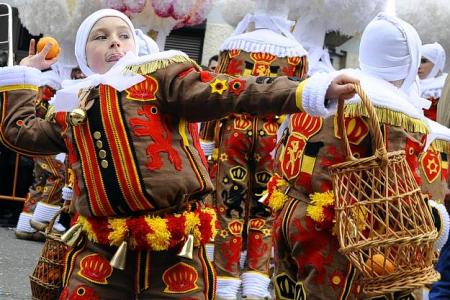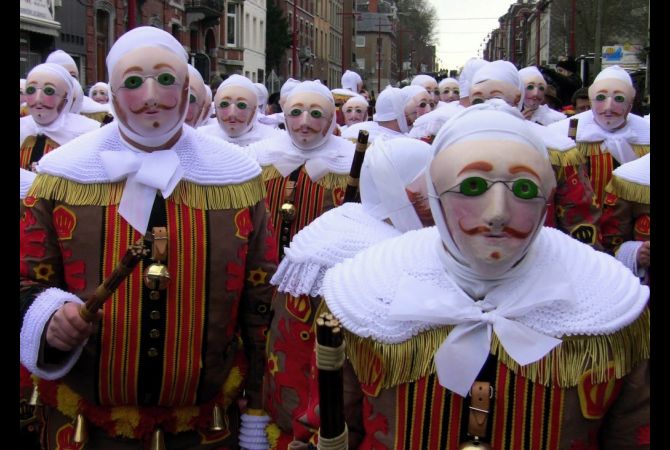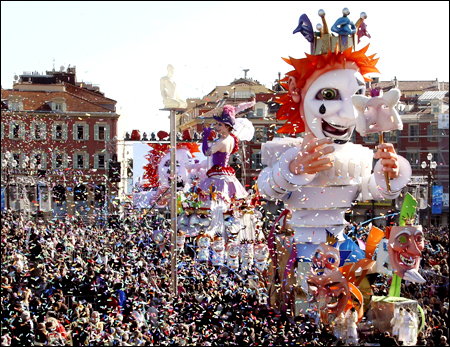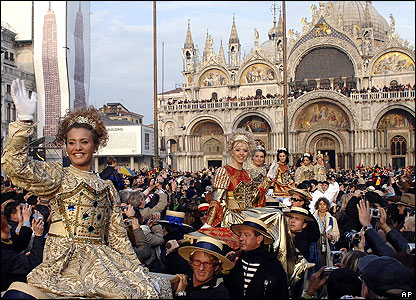Mardi Gras
Krewe du Vieux Rolls and “Begs For Change”!
0The 2015 version of Krewe du Vieux rolled throughout the Marigny, French Quarter, and Central Business District last evening before a large adult crowd, some small children, and a few kids who had no business attending. It was an all new route for the non-profit krewe dedicated to the historical and traditional concept of a Mardi Gras parade as a venue for individual creative expression and satirical comment.
Virtually all the music provided by the parade last night came from brass bands from around New Orleans.- Langiappe, Pinettes, Kinfolk, TBC, New Birth, Jazzmen, Bone Tone, Big Fun, One Love, Young Fellaz, Paulin Bros, Treme, Egg Yolk Jubilee, and Baby Boy. KdV is the top music parade in the city, and that’s no small statement. 20+ great brass bands truly enrich the parade going experience for both the participants and crowd. We march 3.8 miles across Marigny, the Quarter and the CBD, and every step of the way was a joy due to the continuous, non-amplified, mobile concert that accompanied each krewe.
The KdV pre-party was the food highlight of the evening. The abundant Popeyes’ fried chicken, red beans, po-boys, homemade cheesecakes, salads, and finger sandwiches went over very well. The best food I scarfed- marinaded filet mignon sandwich on biscuit with spring greens and goat cheese.
The temperature was in the mid 50s as the parade kicked off. The parade was the peak event of the evening. The brass band marching immediately in front of our mule was the Big Fun Brass Band. Behind me was Underwear stalwart Egg Yolk Jubilee. Both were extraordinary and added a lot of weight to the festivities. Since my position as Escort is next to the float, I mostly heard the band in front of me. After listening to and dancing to them for a couple of hours, I realized how much the band had improved my parade experience.
I have found that the amount of fun to be had being part of a parade is directly related to the amount of throws you have to throw during the parade. If you have enough throws so you can throw from beginning to end, you will have a superlative time. If you have less throws, you may not have as good a time.
Each sub-krewe that collectively make up KdV design their own hard biting, ribald float based on the mother krewe’s 2015 theme, KdV Begs For Change. This makes for well thought out, well constructed floats. I generally include a photo essay from KdV taken before the parade rolls, but after they have left the den and set up in pre-staging before moving to the start of the parade.
Police Shortage is Mardi Gras Security Risk!!
0This is only the second or third story that will go on both of my blogs. Crime and Mardi Gras do occasionally mix.
There are signs all over the French Quarter which state Caution: Walk in Large Groups. We (heart) N.O.P.D. We Just Need More. This isn’t a good sign for a city about to enter one of the biggest holidays of the year, Mardi Gras. Approximately 1 million visitors descend on New Orleans each Carnival season and most will hit the Quarter soon after arriving. They will be greeted by a French Quarter bathed in unsettling signs.
Security is a growing concern to many New Orleanians and Americans. When New Orleans is perceived as a dangerous place, less people make plans to visit. The streets of New Orleans during Carnival are full of state troopers, federal agents, virtually half the police force at one time, plus scads of private security personnel. Downtown there are a lot of weirdos that make it down to Mardi Gras also.
In the last 11 years, at least 27 people were injured and one killed on parade routes and Bourbon Street. That is one horrific statistic. Carnival has historically had a violent side. I personally have been very close on St Charles Avenue to a major shooting incident a decade ago. I’ve had very large groups with me at times and much smaller at other, but no one in my group has ever been accosted on the parade route or downtown or in Metairie or other parades around the metro area.
Another growing trend, private security cameras, have caught many of these assaults and shown the brazenness of the perpetrators. The variety of weapons employed is staggering. This footage shows up on YouTube and adds to our collective anxiety.
Since Katrina, the New Orleans Police Department (NOPD) has lost about 500 officers, and I’ve written about this problem recently on my other blog about jail and justice in New Orleans here. Michael Glasser, president of the Police Association of New Orleans, a police union, says I have been to some roll calls where there is one cop, two cops. Mayor Mitch Landrieu would like around 1,600 officers. I’ve authorized as much overtime as is necessary, says our Mayor.
The Mayor has personally felt the sting of crime very recently. One of his personal vehicles was stolen in front of his home over the weekend. The 2006 Jeep was recovered within blocks of his house by an off duty Jefferson Parish Sheriff’s deputy. The Jeep was equipped with LoJack technology. The deputy was heading home across the Mississippi River bridge after finishing a 12 hour shift. His LoJack receiver in his patrol car picked up the signal. He called in the information and found out the car belonged to the mayor of New Orleans. He followed the signal and found himself near the 2nd District Police station. He stopped and checked in, then began pursuing the stolen vehicle again. He ran into the Jeep at General Taylor and Constance streets.
Turns out the New Orleans police never received the LoJack signal as Jefferson Parish did. Hmmm.
According Glasser, This shows crime is not limited to a handful of people in the traditionally ‘bad areas.’ Anybody can be a victim, and ironically, the victim in this case is the person screaming the loudest that crime is down. And while he admits there’s a staffing shortage, I think he underrates the importance of that.
Mardi Gras Around the World Series- Carnival of Binche, Belgium!!
0This is a smaller Mardi Gras than most, though it is beginning to get on the map due to their heavy duty, one of a kind Mardi Gras tradition. Binche is a Belgian town of 32,000 near the French border. They have a Mardi Gras folk tradition dating back to the 14th century, that UNESCO has designated a cultural treasure in the same class as Japan’s Nôgaku theater and Lithuania’s symbolic cross crafting.
After the early wake-up call, a breakfast of Champagne and oysters is customary. During the carnival, you’ll see Pierrot, Harlequin, and peasant costumes, but the central characters are the Gilles—local men wearing wax masks, wooden clogs, and elaborate black, red, and yellow costumes that are stuffed with hay and adorned with white collars and bells. In the mid-afternoon, nearly 1,000 Gilles converge on the town’s Grand Place, trade their masks for large ostrich-feather headdresses, sing, dance, and pelt the crowd with blood oranges, a symbol of fertility.
The Carnival of Binche is during the Sunday, Monday, and Tuesday preceding Ash Wednesday. The carnival is the best known of several that take place in Belgium at the same time.
Events related to the carnival begin up to seven weeks prior to the primary celebrations. Street performances and public displays traditionally occur on the Sundays approaching Ash Wednesday, consisting of prescribed musical acts, dancing, and marching. Large numbers of Binche inhabitants spend the Sunday directly prior to Ash Wednesday in costume.
The centrepiece of the carnival’s proceedings are the clown-like Gilles. Appearing, for the most part, on Shrove Tuesday, they range in age from 3 to 60 years old, and are customarily male. The honour of being a Gille at the carnival is something that is aspired to by local men. From dawn on the morning of the carnival’s final day, Gilles appear in the centre of Binche, to dance to the sound of drums and ward off evil spirits with sticks.
Later during the day, they don large hats adorned with ostrich plumes, which can cost more than $300 to rent, and march through the town with baskets of oranges. These oranges are thrown to, and sometimes at, members of the crowd gathered to view the procession. The vigour and longevity of the orange-throwing event has in past caused damage to property – some residents choose to seal windows to prevent this. The oranges are considered good luck because they are a gift from the Gilles and it is an insult to throw them back.
Mardi Gras Around the World Series – Carnaval de Nice, France!!
3I’ve been to a major music publishing trade show at the Palais de Festivals in Cannes, France a number of times. Same place as the Cannes Film Festival. The show occurs in January, and more than once we came to France around Mardi Gras time. Nice and Cannes are very close together, both are on the Riviera aka the Mediterranean, they are next door neighbors. So I’ve been to Mardi Gras in Nice a couple of times, and had a very nice and somewhat wild time.
Nice’s Carnaval, which dates back to 1294 and is today the largest in France, includes many iconic trappings of a Mardi Gras celebration. Parades of floats topped with papier-mâché “big heads” make their way down the Place Masséna (the procession is illuminated at night); street performers add to the entertainment; and for the finale, an effigy of King Carnaval is burned and fireworks light up the sky. But the centerpiece of the annual fête is the Flower Battle. A tradition of exchanging bouquets and decorating carriages in the 19th century grew into a gorgeous parade of blossom-bedecked floats.
Until the 18th century, Carnival was punctuated by masked balls and frenzied farandoles (dancers) in the streets of what is now Old Nice. During the major political and military upheavals caused by the French Revolution and the First Napoleonic Empire, Carnival festivities were suspended.
In 1830, a first cortège was organized in honour of King Charles-Felix and Queen Marie-Christine, rulers of Piedmont-Sardinia. Some thirty carriages paraded in front of the monarchs, announcing the future form of Carnival. Any excesses were soon controlled by the “Abbés des Fous” (Fools’ abbots), entrusted by the clergy with supervising the people’s revelry. In 1873, Nice began using decorative staging, float processions and stands for the spectators. It was then that Nice Carnival entered the modern era.
Since 2005, the decorations have synced up with each year’s Carnaval theme (the King of Sport theme for 2012 is in honor of the upcoming London Olympics). Instead of beads, costumed revelers riding the floats toss up to 100,000 flowers into the crowd. Even ganses, a Niçoise variation on fried dough (similar to beignets and bugnes), get a festive flourish of orange flower water.
Mardi Gras Around the World Series- Venice, Italy!!
0From January 31 – February 17, 2015, Venice will slough off the winter gloom and burst into life. During the Carnival (Carnevale), this most magical of cities fills with a mass of masked party-goers – posing and preening, dancing and philandering, in a slightly surreal re-invention of a great tradition of the city.
Glancing at the portrayals of 18th-century Venetian life in the works of Pietro Longhi or Gabriele Bella in the Querini Stampalia gallery (querinistampalia.it) or the Ca’ Rezzonico museum (visitmuve.it) will reveal that that was exactly what Venice in its party prime was all about. It’s not for everybody. It can be intensely crowded, and rates in hotels and restaurants soar. But it is a unique occasion, and a great time to see the city in a new and exciting light.
In truth, those that get here mid-week during the first week might wonder what all the fuss is about: besides the skating rink in Campo San Polo and a handful of low-grade events in out-of-the-way corners, there’s not a lot to keep you busy. If it’s excitement you want, aim for the weekends, and the final weekend in particular. see the carnival website (carnevale.venezia.it) for more details.
– “The Best Masked Costume Contest” in St. Mark’s Square Gran Finale
– Volo dell’Asino (Flight of the Donkey) from the Piazza Ferretto Tower in Mestre
Carnevale: a history of masks
The Venetian propensity for hiding behind masks was legendary: a rigid caste system coupled with ample opportunities for indulging in a host of vices made anonymity very desirable in an overcrowded city where detection was otherwise unavoidable. In the 13th century a law was passed banning masks while gambling. Later norms made it illegal to make masked visits to convents, or to wear masks during many religious festivals.
In the end, it was easier to stipulate when masks could be worn: most importantly, in a crescendo of frantic merry making, from Boxing Day until Shrove Tuesday – the period known as Carnevale (from carnem and vale, Latin for “meat” and “farewell”: a reference to the Church’s ban on eating meat during Lent). The French stamped out the festivities when they took command of the city in 1797. And so it remained until 1979 when it dawned on local authorities that a revamped Carnevale would boost tourism in the city at a quiet, damp, misty time of year. The festival now lasts for two weeks in the run-up to Lent.
Alternatives
If everything to do with Venice’s Carnival gets too much, the Veneto region offers a host of alternatives, including a magnificent procession of floats in Treviso over the final Carnevale weekend, and the carnival in Verona, this latter claiming superiority over Venice having run uninterrupted since 1531. On the Friday before Shrove Tuesday, a great fat “king” parades through the street with a gnocco (dumpling) impaled on his sceptre, at the head of a procession of floats and costumed citizens.
